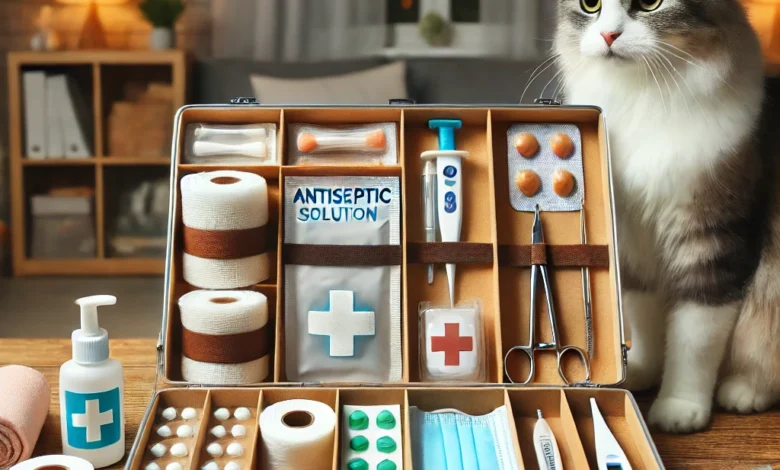Essential First-Aid Kit Supplies Every Cat Owner Should Have

Cats are curious creatures, always finding new ways to explore their surroundings. But sometimes, their adventures can lead to unexpected injuries or health issues. As a responsible cat owner, having a well-stocked first-aid kit can make all the difference in handling minor wounds, illnesses, or emergencies before seeking professional veterinary care.
In this guide, we’ll go over the essential first-aid kit supplies every cat owner should have, ensuring you’re prepared for any situation.
Why Every Cat Owner Needs a First-Aid Kit
Having a cat first-aid kit isn’t just a precaution—it’s a necessity. Cats can get hurt indoors or outdoors, and immediate care can prevent complications. A first-aid kit allows you to:
✔ Handle minor injuries at home
✔ Stabilize your cat before visiting the vet
✔ Act quickly in emergencies, increasing the chances of a full recovery
✔ Provide comfort and relief to your feline friend
Now, let’s dive into the must-have supplies for your cat first-aid kit.
1. Gauze Pads and Bandages
When your cat gets a cut, scratch, or wound, gauze pads and bandages are crucial. They help stop bleeding, protect wounds, and prevent infection.
How to Use Gauze on Your Cat:
- For bleeding wounds: Apply a sterile gauze pad with gentle pressure.
- For larger wounds: Secure the gauze with a non-stick bandage or self-adhesive wrap.
- For minor cuts: A small cotton pad or sterile dressing can help absorb blood.
Tip: Avoid using human adhesive bandages (like band-aids), as they can stick to your cat’s fur and cause discomfort.
Prepare for emergencies with must-have first-aid supplies from https://furlove365.com/.
2. Antiseptic Solution or Wipes
Cats can be sensitive to infections, so cleaning wounds with an antiseptic solution is essential. Look for a non-toxic antiseptic that’s safe for cats.
How to Use Antiseptic on Your Cat:
- Dab a small amount on a clean cotton pad and gently wipe the affected area.
- Avoid alcohol-based antiseptics, as they can sting and cause irritation.
- Use wipes or sprays for quick and easy application on minor wounds.
This helps remove bacteria, dirt, and debris, reducing the risk of infections.
3. Tweezers and Tick Removers
Outdoor cats are prone to getting ticks, splinters, and small debris stuck in their fur or skin. A pair of tweezers or a tick remover tool is essential for removing these safely.
How to Remove a Tick:
- Use fine-tipped tweezers to grasp the tick as close to the skin as possible.
- Gently pull straight out without twisting, to prevent breaking the tick.
- Clean the area with an antiseptic solution.
This simple tool can prevent serious infections and diseases transmitted by ticks.
4. Digital Thermometer
A fever can be a sign of infection, stress, or illness in cats. A digital thermometer helps monitor your cat’s body temperature.
How to Take Your Cat’s Temperature:
- Use a pet-safe digital thermometer (rectal or ear type).
- Apply a small amount of lubricant before inserting it.
- A normal cat temperature ranges between 100.5°F and 102.5°F (38°C – 39.2°C).
If your cat’s temperature is too high or low, seek veterinary attention immediately.
5. Styptic Powder or Pencil (For Bleeding Nails)
Accidentally cutting your cat’s nails too short can cause bleeding. Styptic powder helps stop the bleeding quickly.
How to Use:
- Dip the bleeding nail into the powder or apply it using a cotton swab.
- Hold gentle pressure until bleeding stops.
This is especially useful for regular cat grooming and nail trims.
6. Eye and Ear Cleaning Solutions
Cats can develop eye infections, ear mites, or wax buildup, which may lead to discomfort or serious issues. A gentle cleaning solution for both eyes and ears is a must-have.
How to Clean Your Cat’s Eyes and Ears:
- Use a clean cotton pad with eye-cleaning solution for tear stains or mild infections.
- Apply ear-cleaning drops and gently wipe with a soft cloth or cotton pad.
Regular cleaning prevents infections and keeps your cat comfortable.
7. Hydrogen Peroxide (For Inducing Vomiting – ONLY with Vet Approval)
In case your cat ingests something toxic, a vet may recommend using hydrogen peroxide to induce vomiting. However, never use it without consulting a vet first.
When to Use Hydrogen Peroxide:
✔ If instructed by a vet in case of poisoning
✖ Never use without guidance—some toxins can cause more harm if vomited
Always call your vet or an animal poison control center first.
8. Saline Solution for Wound and Eye Care
Saline solution is an all-purpose first-aid essential for:
✔ Cleaning minor wounds and scratches
✔ Flushing debris from your cat’s eyes
✔ Keeping the affected area moist before treatment
Tip: Use sterile saline solution instead of tap water to prevent irritation.
9. Disposable Gloves
Handling injuries, wounds, or sick cats requires hygiene and safety. Keep disposable gloves in your first-aid kit to protect both you and your cat.
Why Use Gloves?
✔ Prevents infection spread
✔ Keeps wounds clean
✔ Protects you from potential zoonotic diseases
Gloves are especially helpful when handling open wounds or administering medications.
10. Emergency Contact List
Your first-aid kit should include important contact numbers, such as:
– Your veterinarian
– Emergency animal hospital
– Poison control center
This ensures quick action during emergencies without wasting time searching for numbers.
11. Syringe or Dropper for Oral Medications
A syringe or dropper is essential for giving liquid medications, electrolytes, or water to a dehydrated or sick cat.
Tip: Always administer medications as instructed by your vet.
12. Cold and Hot Packs
✔ Cold packs reduce swelling from injuries or insect bites.
✔ Hot packs provide warmth to a cold or sick cat.
Keep these in your first-aid kit for emergency temperature regulation.
13. Muzzle or Soft Towel for Restraining
Even the sweetest cats can panic and scratch when in pain. A muzzle or soft towel helps you safely restrain your cat during treatment.
Tip: Always use gentle handling—never force restraint if your cat is too stressed.
14. Activated Charcoal (Only Under Vet Guidance)
In some poisoning cases, activated charcoal helps absorb toxins. However, always consult a vet before administering it.
✔ Can be lifesaving in emergency poisoning situations
✖ Only use if recommended by a professional
15. Pet-Safe Pain Relief (Vet Approved Only)
NEVER use human pain relievers, as they can be toxic to cats. Ask your vet for a pet-safe pain medication to keep in your kit for emergencies.
Final Thoughts
A first-aid kit is an essential part of cat ownership. It helps you handle minor injuries, prevent infections, and provide temporary relief in emergencies before seeing a vet.
Stay prepared, stay calm, and keep your furry friend safe!



